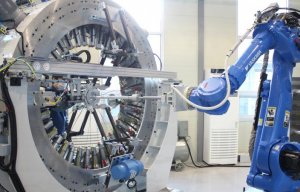
Australia’s first dual-ring industrial scale braider
Decades after many people thought the US textile industry was dead, the industry generated $54 billion in shipments in 2012 and employed about 233,000 people. Business is on the upswing as Southern states, in particular, woo textile companies with tax breaks, reliable utilities, modern ports and airports and a dependable, trained and non union workforce. In 2013, companies in Brazil, Canada, China, Dubai, Great Britain, India, Israel, Japan, Korea, Mexico and Switzerland, as well as in the US, announced plans to open or expand textile plants in Georgia, Louisiana, North Carolina, South Carolina, Tennessee and Virginia.

6th February 2014
Innovation in Textiles
|
Washington
Decades after many people thought the US textile industry was dead, the industry generated $54 billion in shipments in 2012 and employed about 233,000 people.
Business is on the upswing as Southern states, in particular, woo textile companies with tax breaks, reliable utilities, modern ports and airports and a dependable, trained and non union workforce.
In 2013, companies in Brazil, Canada, China, Dubai, Great Britain, India, Israel, Japan, Korea, Mexico and Switzerland, as well as in the US, announced plans to open or expand textile plants in Georgia, Louisiana, North Carolina, South Carolina, Tennessee and Virginia.
The workers produce yarn, thread and fabric for apparel, furnishings, home products and industrial use. Examples include Huggies and Pampers diapers, Swiffer mops and Pledge furniture wipes, according to David Rousse, president of the Association of the Nonwoven Fabrics Industry.
“Textiles manufacturing – yarn, fabric, woven and nonwoven – is still here and growing,” said A. Blanton Godfrey, dean of the College of Textiles at North Carolina State University. “We’re selling cotton yarn cheaper than the Chinese.”
True, textile manufacturing in the US dropped precipitously in the 1990s and 2000s as cheaper labour drew jobs overseas. Automation and increased productivity of textile mills also cost jobs. More than 200,000 textile manufacturing jobs have been lost to automation in the last decade.
Textiles, mostly cotton, once dominated the economy of the South. Employment peaked in June 1948 with 1.3 million jobs. In just one state, North Carolina, 40 percent of its jobs were in textile and apparel manufacturing in 1940. By 2013, just 1.1 percent of that state’s jobs were in textiles.
But rising wages in China and other countries, combined with higher transportation costs and tariffs, have prompted foreign and domestic companies to consider American manufacturing sites. Also, with more consumers looking for the “Made in the USA” label, some companies are turning to American goods. Wal-Mart, for example, pledged last year to buy $50 billion over a decade in American-made products, among them towels and washcloths.
More than a third of all textile jobs were located in Georgia and North Carolina in 2012, and that’s where many of the jobs are being created. The new plants are nothing like the dusty, noisy mills of the past.
These highly automated plants require far fewer — but more tech-savvy — workers who earn higher pay than their forebears. The average textile wage in the US in 2012 was $37,900, compared with $60,496 for all manufacturing jobs. In North Carolina, the average textile wage was $33,219, up from $28,216 in 2002.
Another change in the industry is the growth of nonwovens, which are fibre-based products made of fabric that’s compressed, heated or tangled, like felt. Diapers and facial wipes, mops, medical scrubs and all kinds of filters are nonwovens. In the last decade, North Carolina has gained 1,945 jobs making nonwoven products and $719 million in nonwoven factory investment.
“It’s not your grandmother’s textile mill,” said economist Ted Abernathy, whose four grandparents worked in textile mills while he was growing up in North Carolina. The long-time executive director of the Southern Growth Policies Board until it merged last fall with the Southern Governors’ Association, Abernathy now is a consultant to the governors’ group.
“The good news for the South is that the lowest-end jobs are not coming back,” Abernathy said. “New jobs are in the $35,000 to $45,000 a year range.”
In North Carolina, nine textile firms announced plans in 2013 to build or expand plants in the state, creating 993 jobs and investing $381 million. Sharon Decker, the state secretary of commerce, cited three factors that helped her state win the new factories: culture, education and a competitive business climate.
“North Carolina has a historically strong manufacturing base, in textiles especially,” Decker said. “The notion of a culture of textile manufacturing – people know it’s still there.”
The state offered grants totalling $4.4 million to the nine textile companies to create jobs. The largest in the group is Gildan Activewear, a Canadian firm that has committed to invest $250 million and hire 500 workers. Gildan received a $3.5 million state Job Development Investment Grant, a cash grant based on actual job creation.
Meanwhile, the state university’s textiles school works with the business sector to help prepare workers for the new jobs, Decker said.
One challenge these days is getting young people interested in textile factory work, she said. One mill owner has started bringing middle school students in for tours to show them how technologically advanced the facilities are.
Stateline is a nonpartisan, nonprofit news service of the Pew Charitable Trusts that provides daily reporting and analysis on trends in state policy. www.pewstates.org

Business intelligence for the fibre, textiles and apparel industries: technologies, innovations, markets, investments, trade policy, sourcing, strategy...
Find out more